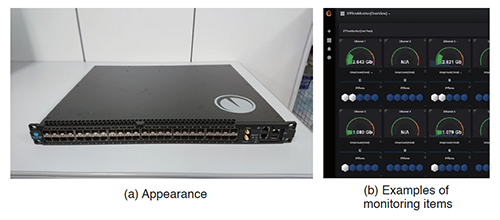Research Area
3.4 IP-based program production technologies
Studies have been conducted on a shift of the interface for broadcasters' program production systems from the conventional Serial Digital Interface (SDI) format to the Internet Protocol (IP) format. The IP format can reduce equipment costs and enable the efficient multiplexing transmission of various signals including video from multiple cameras and multichannel sound over a single cable. It is also expected to bring benefits such as a new program production workflow involving program production from remote areas (remote production).
To achieve an IP-based program production system, we are conducting R&D on IP transmission equipment for lightweight-compressed 8K signals, which enables efficient IP transmission of 8K program contributions in a limited bandwidth, an uncompressed 8K division transmission method for the shared use of program production equipment among 2K, 4K and 8K, IP flow real-time monitoring equipment capable of quality monitoring of IP signals, and the technical verification of IP live production using these systems.
■IP transmission equipment for lightweight-compressed 8K signals
In FY 2018, we worked to improve the functions of the IP transmission equipment for lightweight-compressed 8K signals that we developed in FY 2017.
Using IP networks for transmitting program contributions has the advantage of keeping network costs low because other service providers' signals are also transmitted together over the same networks. Meanwhile, there is the challenge of how to ensure the stable transmission of program contributions even at the time of channel switchover due to network congestion or maintenance. As a measure to handle the degradation of network quality such as congestion, in FY 2018, we implemented a packet-loss correction coding scheme, which is resistant to burst-type packet loss, into our lightweight-compressed 8K IP transmission equipment. As a measure to deal with a channel switchover, we also implemented the redundancy of IP signals between the transmitter and receiver sides and a function that allows a variable setting for packet buffering time.
To verify the effectiveness of the lightweight-compressed 8K IP transmission equipment added with the two functions, we conducted laboratory experiments using a device that can simulate a channel error. The results demonstrated that stable video transmission can be achieved even when packet loss occurs.
■Uncompressed 8K division transmission method
We developed a method for dividing uncompressed 8K video into multiple 2K video streams and transmitting them as multiple IP flows. This method enables the transmission of uncompressed 8K video using multiple wide-band lines such as widely available 10GbE/25GbE. It also allows the use of divided 2K video for preview and 8K switching process by synchronizing multiple 2K switchers. Moreover, it enables the shared use of program production equipment among 2K, 4K and 8K because it allows 2K program production equipment to be used for 8K program production.
We exhibited a switching system using this method at the NHK STRL Open House 2018 and Inter BEE 2018 and presented the research results at the SMPTE conference(1).
■IP flow real-time monitoring equipment
While the IP network, unlike SDI, allows multiple video and sound materials to share a single network, it can cause jitter and packet loss in transmitted signals. This requires the monitoring of signal quality at the IP packet level and we therefore developed equipment that can monitor IP flows in real time (Figure 3-8). This equipment consists of hardware that extracts the header information from IP packets and software that analyzes the header information. As a feature, it can monitor 16 10GbE networks simultaneously by limiting the target of process to the header information. Also, the analysis software can visualize and present transmission latency and the communication status of controlling signals for each IP flow as well as basic indicators such as jitter and packet loss.
We used this equipment for the real-time monitoring of signals flowing over IP networks in the transmission experiments for IP remote production to be described later and demonstrated that it was helpful for identifying the cause of network congestion.

Figure 3-8. IP flow real-time monitoring equipment
■Verification of IP live production technology
To verify the interoperability between IP live production devices and identify the issues of IP remote production, we conducted technical verifications of IP live production using IP-enabled program production equipment of various vendors in cooperation with the Outside Broadcast Engineering Division.
We demonstrated that broadcasting equipment of different vendors can be interconnected by using the SMPTE ST 2110 transmission standard for program production on IP networks. We also confirmed that an SDI system and an IP system can be interconnected for operation by using SMPTE ST 2059-1/2, which defines synchronized transmission and the phase of vertical video synchronization over IP networks. Meanwhile, we identified issues about monitoring and control technologies caused by IP implementation, such as network congestion and different versions of controlling signals in accordance with equipment. We shared information with the vendors to resolve these issues.
| [References] | |
| (1) | T. Koyama, J. Kawamoto, M. Kawaragi, T. Kurakake and K. Saito: "Implementation of 8K vision mixer that transports 8K image as multiple 2K SMPTE ST 2110-20 flows," SMPTE 2018 Annual Technical Conference & Exhibition, pp. 1-11 (2018) |